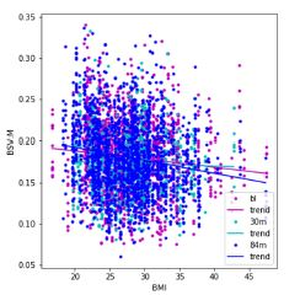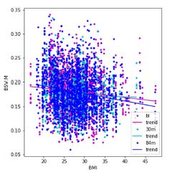Information
- Publication Type: Master Thesis
- Workgroup(s)/Project(s):
- Date: June 2018
- Date (Start): 3. January 2018
- Date (End): 27. June 2018
- Open Access: yes
- First Supervisor: Eduard Gröller

Abstract
This master thesis aims to provide an in-depth comparison of four texture algorithms
in their capacity of discriminating patients with osteoarthritis (OA) from the ones without, recognizing early signs of Osteoarthritis and tracking disease progression from 2D radiographs of the knee trabecular bone (TB). Given the fractal properties of the trabecular bone (TB), two fractal-based algorithms (Bone Variance Value (BVV) and Bone Score Value (BSV)) that try to characterize the complexity of the underlying 3D structure of the bone are presented. The third algorithm (Bone Entropy Value (BEV), based on Shannon’s Entropy) stems from the information theory and aims to describe the bone structure in terms of information complexity. The last algorithm (Bone Coocurrence Value (BCV)) is based on the co-occurrence matrix of an image and describes the image texture in terms of certain Haralick features. If successful, such algorithms posses a great potential to lower the costs (financial, time) associated with the diagnosis of osteoarthritis (OA) through automation of the procedure, and with the treatment. The earlier treatments and risk reduction measures are less costly than the
procedures involved due to a more advanced stage of the disease (surgery, implants, etc.).
First, a motivation for the detection of early osteoarthritis (OA) is given. Second, a detailed description and mathematical background of the algorithms are presented and validated on sample, artificial data. Third, the employed data sets used for classification tests are introduced. Fourth, the statistical methods and neural network models employed are presented and discussed. Fifth, the features produced by each algorithm are discussed and their independent and combined capacity of discriminating between bones with early signs of OA and healthy bones. Also the capacity of tracking OA progression
through the years is quantified by statistical tests. Also in this part we present the best classification scores obtained from the most optimal neural networks for each use case. Finally, thoughts on future improvements and the generalization of the algorithms in other anatomical contexts, for other diseases or in other fields, like histology and
mammography, are made.
In this work we show that the state-of-the-art in OA prediction can be surpassed by
utilizing only models based on texture features alone. Our gender-stratified analysis produces a prediction score of 83% for males and 81% for females in terms of Area Under the Receiver Operating Characteristic Curve (ROC-AUC).
Additional Files and Images
Additional images and videos
Additional files
Weblinks
No further information available.
BibTeX
@mastersthesis{Oancea_2018_1,
title = "Four Texture Algorithms for Recognizing Early Signs of
Osteoarthritis. Data from the Multicenter Osteoarthritis
Study.",
author = "Stefan Ovidiu Oancea",
year = "2018",
abstract = "This master thesis aims to provide an in-depth comparison of
four texture algorithms in their capacity of discriminating
patients with osteoarthritis (OA) from the ones without,
recognizing early signs of Osteoarthritis and tracking
disease progression from 2D radiographs of the knee
trabecular bone (TB). Given the fractal properties of the
trabecular bone (TB), two fractal-based algorithms (Bone
Variance Value (BVV) and Bone Score Value (BSV)) that try to
characterize the complexity of the underlying 3D structure
of the bone are presented. The third algorithm (Bone Entropy
Value (BEV), based on Shannon’s Entropy) stems from the
information theory and aims to describe the bone structure
in terms of information complexity. The last algorithm (Bone
Coocurrence Value (BCV)) is based on the co-occurrence
matrix of an image and describes the image texture in terms
of certain Haralick features. If successful, such algorithms
posses a great potential to lower the costs (financial,
time) associated with the diagnosis of osteoarthritis (OA)
through automation of the procedure, and with the treatment.
The earlier treatments and risk reduction measures are less
costly than the procedures involved due to a more advanced
stage of the disease (surgery, implants, etc.). First, a
motivation for the detection of early osteoarthritis (OA) is
given. Second, a detailed description and mathematical
background of the algorithms are presented and validated on
sample, artificial data. Third, the employed data sets used
for classification tests are introduced. Fourth, the
statistical methods and neural network models employed are
presented and discussed. Fifth, the features produced by
each algorithm are discussed and their independent and
combined capacity of discriminating between bones with early
signs of OA and healthy bones. Also the capacity of tracking
OA progression through the years is quantified by
statistical tests. Also in this part we present the best
classification scores obtained from the most optimal neural
networks for each use case. Finally, thoughts on future
improvements and the generalization of the algorithms in
other anatomical contexts, for other diseases or in other
fields, like histology and mammography, are made. In this
work we show that the state-of-the-art in OA prediction can
be surpassed by utilizing only models based on texture
features alone. Our gender-stratified analysis produces a
prediction score of 83% for males and 81% for females in
terms of Area Under the Receiver Operating Characteristic
Curve (ROC-AUC).",
month = jun,
address = "Favoritenstrasse 9-11/E193-02, A-1040 Vienna, Austria",
school = "Institute of Computer Graphics and Algorithms, Vienna
University of Technology ",
URL = "https://www.cg.tuwien.ac.at/research/publications/2018/Oancea_2018_1/",
}

 image
image poster
poster


